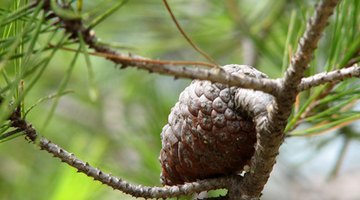The Difference Between Pine & Fir Lumber
Wood provides structural integrity and an attractive natural finish for flooring, cabinetry and furniture. Pine and fir lumber, both used extensively in the construction industry, have a long and valuable place in the history of wood construction. While pine and fir are similar in some aspects, they differ in others.

Wood Characteristics
Both pine and fir are aromatic, especially when cut, due to high resin levels in the wood. Both are softwoods, but pine ranges in color from nearly white to gold, while fir features an orange or reddish hue. Fir’s wood grain is fine and may contain mottled shades of pink and brown, while pine’s wood grain is uniform and smooth, with fewer markings. Knots in both woods indicate a potentially weak area.
Uses
Fir and pine are both suited to the construction of country and rustic style furniture. Both woods are relatively inexpensive and can be used as flooring and trim and structural framing studs.
Cutting, Sanding and Finishing
Pine is easier to cut than fir, and it is less likely to warp and twist before it’s finished. Fir requires a quick application of stain and finish to reduce the risk of warping. Finishes for pine include the application of a wood stain that mimics a more expensive hardwood, while fir may be stained or finished with just a clear coat. Pine is often painted because its grain isn’t naturally attractive. Fir may be stained and sealed immediately after sanding. Pine, however, requires an application of pine sealer (or sanding sealer) before staining to prevent uneven stain absorption. Natural fir accepts wood stain easily and uniformly.
Limitations
Both woods are suitable for flooring, but both require a hard surface finish to protect the wood from gouges. Neither pine nor fir is suitable for exterior building projects unless sealed and painted to prevent weathering.
References
- Craftsman Style: Douglas Fir and White Fir
- Craftsman Style: Pine Wood Characteristics & Types
- “The Woodworker’s Handbook”; Roger Horwood; 2003
Resources
Writer Bio
Glenda Taylor is a contractor and a full-time writer specializing in construction writing. She also enjoys writing business and finance, food and drink and pet-related articles. Her education includes marketing and a bachelor's degree in journalism from the University of Kansas.
Photo Credits
- Pine cone image by matko from Fotolia.com
- Pine cone image by matko from Fotolia.com
More Articles



